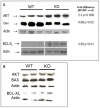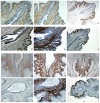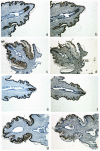The anti-metastatic nm23-1 gene is needed for the final step of mammary duct maturation of the mouse nipple
- PMID: 21490937
- PMCID: PMC3072419
- DOI: 10.1371/journal.pone.0018645
The anti-metastatic nm23-1 gene is needed for the final step of mammary duct maturation of the mouse nipple
Abstract
Nm23/NDP kinases are multifunctional enzymes involved in the general homeostasis of triphosphate nucleosides. Numerous studies have shown that NDPKs also serve as regulatory factors of various cell activities, not always connected to nucleotide phosphorylation. In particular, the nme-1 gene, encoding the NM23-1/NDPKA protein, has been reported as a metastasis suppressor gene. This activity was validated in hepatocellular tumors induced in nm23-1 deficient mice. Yet, data describing the primary physiological functions of nm23-1/NDPKA is still scarce. We have characterized in depth the phenotype of nm23-1 deletion in the mammary gland in mice carrying whole body nm23-M1 invalidation. We also asked why the nm23-M1⁻/⁻ mutant females displayed severe nursing disability. We found that the growth retardation of mutant virgin glands was due to reduced proliferation and apoptosis of the epithelial cells within the terminal end buds. The balance of pro/anti-apoptotic factors was impaired in comparison with wild type glands. In the lactating glands, the reduced proliferation rate persisted, but the apoptotic factors were unchanged. However, those defects did not seem to affect the gland maturation since the glands lacking nm23-1/NDPKA appeared morphologically normal. Thorough examination of all the functional aspects of the mammary glands revealed that lack of nm23-1/NDPKA does not impact the production or the ejection of milk in the lumen of lobuloalveolae. Interestingly, an epithelial plug was found to obstruct the extremity of the unique lactiferous duct delivering the milk out of the nipple. These cells, normally disappearing after lactation takes place, persisted in the mutant nipples. This work provides a rare instance of nm23-1/NDPKA physiological functions in the mammary glands and reveals its implication as a modulator factor of proliferation and apoptosis in this tissue.
Conflict of interest statement
Figures








Similar articles
-
Nm23-M2/NDP kinase B induces endogenous c-myc and nm23-M1/NDP kinase A overexpression in BAF3 cells. Both NDP kinases protect the cells from oxidative stress-induced death.Exp Cell Res. 2004 Dec 10;301(2):293-304. doi: 10.1016/j.yexcr.2004.07.026. Exp Cell Res. 2004. PMID: 15530864
-
Increased levels of nm23 H1/nucleoside diphosphate kinase A mRNA associated with adenocarcinoma of the prostate.World J Urol. 1996;14 Suppl 1:S21-5. doi: 10.1007/BF00182060. World J Urol. 1996. PMID: 8738406
-
Local over-expression of prolactin in differentiating mouse mammary gland induces functional defects and benign lesions, but no carcinoma.J Endocrinol. 2006 Aug;190(2):271-85. doi: 10.1677/joe.1.06829. J Endocrinol. 2006. PMID: 16899561
-
The Nm23-H1-h-Prune complex in cellular physiology: a 'tip of the iceberg' protein network perspective.Mol Cell Biochem. 2009 Sep;329(1-2):149-59. doi: 10.1007/s11010-009-0115-4. Epub 2009 Apr 24. Mol Cell Biochem. 2009. PMID: 19390954 Review.
-
[NM23, an example of a metastasis suppressor gene].Bull Cancer. 2012 Apr 1;99(4):431-40. doi: 10.1684/bdc.2012.1550. Bull Cancer. 2012. PMID: 22429909 Review. French.
Cited by
-
miR-132/212 knockout mice reveal roles for these miRNAs in regulating cortical synaptic transmission and plasticity.PLoS One. 2013 Apr 26;8(4):e62509. doi: 10.1371/journal.pone.0062509. Print 2013. PLoS One. 2013. PMID: 23658634 Free PMC article.
-
Loss of the Metastasis Suppressor NME1, But Not of Its Highly Related Isoform NME2, Induces a Hybrid Epithelial-Mesenchymal State in Cancer Cells.Int J Mol Sci. 2021 Apr 2;22(7):3718. doi: 10.3390/ijms22073718. Int J Mol Sci. 2021. PMID: 33918324 Free PMC article.
-
Signatures of diversifying selection in European pig breeds.PLoS Genet. 2013 Apr;9(4):e1003453. doi: 10.1371/journal.pgen.1003453. Epub 2013 Apr 25. PLoS Genet. 2013. PMID: 23637623 Free PMC article.
-
Nucleoside diphosphate kinases (NDPKs) in animal development.Cell Mol Life Sci. 2015 Apr;72(8):1447-62. doi: 10.1007/s00018-014-1803-0. Epub 2014 Dec 24. Cell Mol Life Sci. 2015. PMID: 25537302 Free PMC article. Review.
-
NME/NM23/NDPK and Histidine Phosphorylation.Int J Mol Sci. 2020 Aug 14;21(16):5848. doi: 10.3390/ijms21165848. Int J Mol Sci. 2020. PMID: 32823988 Free PMC article. Review.
References
-
- Boissan M, Dabernat S, Peuchant E, Schlattner U, Lascu I, et al. The mammalian Nm23/NDPK family: from metastasis control to cilia movement. Mol Cell Biochem. 2009;329:51–62. - PubMed
-
- Steeg PS, Bevilacqua G, Sobel ME, Liotta LA. Identification and characterization of differentially expressed genes in tumor metastasis: the nm23 gene. Basic Life Sci. 1991;57:355–360; discussion 360-351. - PubMed
-
- Steeg PS, Bevilacqua G, Kopper L, Thorgeirsson UP, Talmadge JE, et al. Evidence for a novel gene associated with low tumor metastatic potential. J Natl Cancer Inst. 1988;80:200–204. - PubMed
-
- Boissan M, Wendum D, Arnaud-Dabernat S, Munier A, Debray M, et al. Increased lung metastasis in transgenic NM23-Null/SV40 mice with hepatocellular carcinoma. J Natl Cancer Inst. 2005;97:836–845. - PubMed
Publication types
MeSH terms
Substances
LinkOut - more resources
Full Text Sources
Molecular Biology Databases
Research Materials

